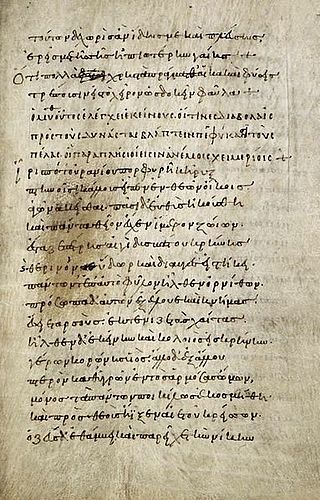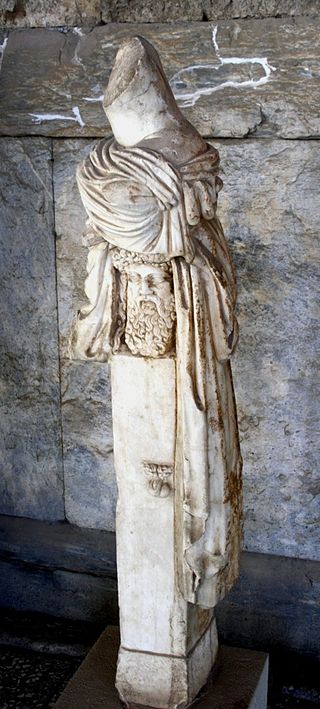
Aesop sometimes plays a part in his own fables where the circumstances in which he tells the story are mentioned. In this he is mocked by a Ferryman, or boat-builders in another account, and tells them how they will soon be out of a job.

Aesop sometimes plays a part in his own fables where the circumstances in which he tells the story are mentioned. In this he is mocked by a Ferryman, or boat-builders in another account, and tells them how they will soon be out of a job.
Aristotle mentions in his Meteorologica how Aesop once teased a ferryman by relating to him a myth concerning Charybdis. With one gulp of the sea she brought the mountains to view; islands appeared after the next. The third is yet to come and will dry the sea altogether, thus depriving the ferryman of his livelihood. [1] Aristotle's reason for reporting this was in connection with the belief of the pre-Socratic philosopher Democritus that the sea's level was gradually lowering and that it would eventually disappear. [2]
Some centuries later, a similar retort was recorded by Babrius when Aesop was mocked by shipbuilders. In this case he told them the creation myth in which the king of the gods wished to make dry land emerge when there was only chaos and water. Earth was therefore commanded to take three gulps, the third of which will dry up the sea altogether. [3] The fable is numbered 8 in the Perry Index. Babrius commented on the situation that people who cheek those smarter than themselves are asking for trouble.
Charybdis is a sea monster in Greek mythology. Charybdis, along with the sea monster Scylla, appears as a challenge to epic characters such as Odysseus, Jason, and Aeneas. Scholarship locates her in the Strait of Messina.

Fable is a literary genre defined as a succinct fictional story, in prose or verse, that features animals, legendary creatures, plants, inanimate objects, or forces of nature that are anthropomorphized, and that illustrates or leads to a particular moral lesson, which may at the end be added explicitly as a concise maxim or saying.

Babrius, also known as Babrias (Βαβρίας) or Gabrias (Γαβρίας), was the author of a collection of Greek fables, many of which are known today as Aesop's Fables.

Aesop's Fables, or the Aesopica, is a collection of fables credited to Aesop, a slave and storyteller who lived in ancient Greece between 620 and 564 BCE. Of varied and unclear origins, the stories associated with his name have descended to modern times through a number of sources and continue to be reinterpreted in different verbal registers and in popular as well as artistic media.

The Boy Who Cried Wolf is one of Aesop's Fables, numbered 210 in the Perry Index. From it is derived the English idiom "to cry wolf", defined as "to give a false alarm" in Brewer's Dictionary of Phrase and Fable and glossed by the Oxford English Dictionary as meaning to make false claims, with the result that subsequent true claims are disbelieved.

The Fox and the Grapes is one of Aesop's Fables, numbered 15 in the Perry Index. The narration is concise and subsequent retellings have often been equally so. The story concerns a fox that tries to eat grapes from a vine but cannot reach them. Rather than admit defeat, he states they are undesirable. The expression "sour grapes" originated from this fable.

The Frog and the Ox appears among Aesop's Fables and is numbered 376 in the Perry Index. The story concerns a frog that tries to inflate itself to the size of an ox, but bursts in the attempt. It has usually been applied to socio-economic relations.
The lion's share is an idiomatic expression which now refers to the major share of something. The phrase derives from the plot of a number of fables ascribed to Aesop and is used here as their generic title. There are two main types of story, which exist in several different versions. Other fables exist in the East that feature division of prey in such a way that the divider gains the greater part - or even the whole. In English the phrase used in the sense of nearly all only appeared at the end of the 18th century; the French equivalent, le partage du lion, is recorded from the start of that century, following La Fontaine's version of the fable.
In Greek mythology, Polemos or Polemus was a daemon; a divine personification or embodiment of war. No cult practices or myths are known for him, and as an abstract representation he figures mainly in allegory and philosophical discourse. The Roman counterpart of this figure was Bellum.

The Farmer and the Stork is one of Aesop's Fables which appears in Greek in the collections of both Babrius and Aphthonius and has differed little in the telling over the centuries. The story relates how a farmer plants traps in his field to catch the cranes and geese that are stealing the seeds he has sown. When he checks the traps, he finds among the other birds a stork, who pleads to be spared because it is harmless and has taken no part in the theft. The farmer replies that since it has been caught in the company of thieves, it must suffer the same fate. The moral of the story, which is announced beforehand in the oldest texts, is that associating with bad companions will lead to bad consequences.

The Tortoise and the Birds is a fable of probable folk origin, early versions of which are found in both India and Greece. There are also African variants. The moral lessons to be learned from these differ and depend on the context in which they are told.

Aesop is an almost certainly legendary Greek fabulist and storyteller, said to have lived c. 620–564 BCE, and credited with a number of fables now collectively known as Aesop's Fables. Although his existence remains unclear and no writings by him survive, numerous tales credited to him were gathered across the centuries and in many languages in a storytelling tradition that continues to this day. Many of the tales associated with him are characterized by anthropomorphic animal characters.
The Ass in the Lion's Skin is one of Aesop's Fables, of which there are two distinct versions. There are also several Eastern variants, and the story's interpretation varies accordingly.

Speaking of The Snake and the Crab in Ancient Greece was the equivalent of the modern idiom, 'Pot calling the kettle black'. A fable attributed to Aesop was eventually created about the two creatures and later still yet another fable concerning a crab and its offspring was developed to make the same point.
Developed by authors during Renaissance times, the story of an ass eating thistles was a late addition to collections of Aesop's Fables. Beginning as a condemnation of miserly behaviour, it eventually was taken to demonstrate how preferences differ.

Hercules and the Wagoner or Hercules and the Carter is a fable credited to Aesop. It is associated with the proverb "God helps those who help themselves", variations on which are found in other ancient Greek authors.

There are five fables of ancient Greek origin that deal with the statue of Hermes. All have been classed as burlesques that show disrespect to the god involved and some scepticism concerning the efficacy of religious statues as objects of worship. Statues of Hermes differed according to function and several are referenced in these stories. Only one fable became generally retold in later times, although two others also achieved some currency.
The Fisherman and his Flute appears among Aesop’s Fables and is numbered 11 in the Perry Index. Wide variations on the theme have existed over the centuries.
The Frog and the Fox is one of Aesop's Fables and is numbered 289 in the Perry Index. It takes the form of a humorous anecdote told against quack doctors.

The Weasel and Aphrodite, also known as Venus and the Cat is one of Aesop's Fables, numbered 50 in the Perry Index. A fable on the cynic theme of the constancy of one's nature, it serves as a cautionary tale against trusting those with evil temper, for even if they might change their body, they will not change their mind.